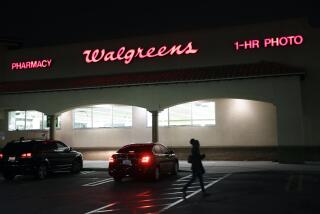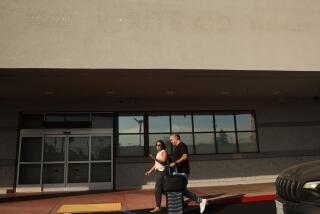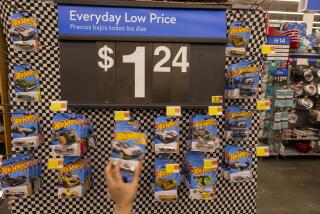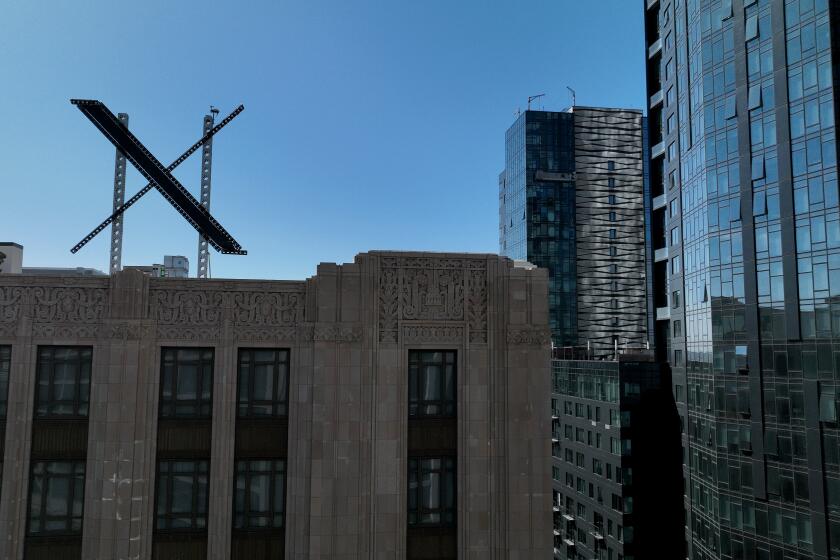ANALYSIS : Survival-of-the-Fittest Shakeout Is Forcing Merchants to Face Past Sins : Retailing: The industry’s woes run deeper than the latest swing in the economy. They include slowness to automate, failure to recruit aggressive managers and the overbuilding of shopping centers.
The past year, especially the holiday shopping season, was dreary for many merchants, but it wasn’t bad enough to explain most of the tumult sweeping through retailing.
Even the hefty buyout debts that strap some retailers are frequently only a catalyst--rather than the underlying cause--of the skyrocketing number of bankruptcies, store closings and layoffs.
The industry is going through a survival-of-the-fittest shakeout that, analysts say, stems largely from a massive overbuilding of shopping centers during the late 1970s and 1980s. On top of that, retailers are now paying dearly for years of myopia.
Most retailers have automated slowly, failed to recruit top-notch talent and given short shrift to consumer research. Experts say that weak merchants also have let themselves nearly bleed to death before shutting money-losing stores.
Retailing is the last major industry rife with “management by the seat of the pants,” contended Douglas J. Tigert, a professor of retail marketing at Babson College in Massachusetts.
Many of today’s top executives “grew up in an era when it was easy to win,” he said. “Now you’ve got to be the best to make money.”
The consequences of past sins could be far-reaching. According to one study, merchants now accounting for half of the nation’s retail sales will have been bought or shut down by the year 2000.
Consumers will be treated to a bounty of price wars as stores struggle to attract enough business to survive. But growth will fade in retailing employment--an entryway, albeit a low-paying one, into the work force for many unskilled people.
After climbing 3.7% annually since 1982, retailing employment inched up 1.1% in 1990 and actually declined in the second half of the year.
Moreover, the upheaval in retailing has begun rippling through other industries. Construction of shopping centers appears to be slowing. Banks are being stung by unpaid retailing loans. Newspaper advertising is shrinking.
And some small suppliers, including apparel firms, have gone broke after retailers slipped into bankruptcy without paying their bills.
Still, the retailing shakeout has a silver lining for merchants that have played it smart--in other words, the companies that have succeeded in keeping their balance sheets debt-free, in embracing labor-saving technology and in simply doing a good job of satisfying customers.
“Now is really the time to eliminate weak competitors and gain market share,” said C. Scott Killips, a partner in the consulting firm Booz, Allen & Hamilton.
Killips predicted that strong companies will squeeze their rivals in coming years by stocking their stores amply while their cash-starved competitors’ shelves are looking bare.
Also, he said, many of the healthy, aggressive companies will mark down prices sharply, often to levels where they can make money but their less-efficient competitors can’t.
Killips has gone on temporary leave from Booz Allen to serve as chairman of 24 Hour Video, a Vancouver-based company that bills itself as the fifth-largest video rental chain in North America. And, at 24 Hour Video, Killips is practicing what he preaches: The company is trying to fill its racks with deeper supplies of new hit releases than its competitors can afford to stock.
The idea is to create a lasting impression among consumers that if you want to be sure to find a hot new release, 24 Hour Video is the place to go.
Meanwhile, Killips is trying to buy some of his struggling competitors, a relatively inexpensive way to expand quickly.
Far bigger retailers also like the current acquisition market. For instance, May Department Stores of St. Louis, the nation’s No. 1 department store company, last month bought the Richmond, Va.-based chain Thalhimers from debt-heavy Carter Hawley Hale Stores of Los Angeles.
Analysts say that the likely winners and losers in the retailing shakeout are separated, in many cases, by how well they use computer technology.
Sears, Roebuck & Co. has been criticized for being slow to computerize and maintaining a bloated work force. Its operating expenses--principally payroll and real estate costs--are estimated to be 30% of annual revenues, possibly the highest in the industry.
To catch up with leaner competitors, Sears this month announced it would cut 3,500 full-time jobs and 17,500 part-time positions in the first half of this year--perhaps the biggest single employment cutback ever in retailing.
What has been keeping all of those supposedly excess workers busy? Old-fashioned work procedures. For example, it sometimes takes Sears stores 2 1/2 hours to unload a truckload of merchandise. That’s largely because its employees log incoming items manually, using paper and pencil.
Now, however, computerized bar-code scanners are being introduced at the stores to record shipments. No more paper and pencil. The result: truck unloading is expected to become a 30-minute job.
That use of electronics already is standard procedure at Wal-Mart, a booming discount chain. Its operating expenses amount to about 16% of revenues, the lowest among the nation’s top general merchandise chains. Wal-Mart insists that all of the merchandise in its stores carry bar codes, allowing the company to track every item electronically from the warehouse to the shelves to the cash register.
Consequently, analysts say, Wal-Mart can hold staffing down and still pinpoint sales trends--and even theft--probably as well as anyone in retailing.
“It’s a fool-proof inventory control system,” said Thomas H. Friedman, publisher of the Retail Systems Alert newsletter.
Wal-Mart also shares electronic data on inventory at each of its stores with major suppliers to enable the vendors to automatically ship new merchandise when needed. As a result, no one at Wal-Mart needs to waste time placing an order with those suppliers. The company can keep its shelves full and its inventories lean at the same time.
By and large, however, U.S. retailers other than supermarket chains have been slow to exploit computer technology. Friedman said that in the convenience store business, for example, U.S. firms are far behind Ito-Yokado, the parent of 7-Eleven Japan Co.
Ito-Yokado uses data from computerized cash registers to determine how to make the best use of its stores’ limited shelf space. Its information is so precise that it can stock its shelves with fresh breakfast foods every night, sell it, and then refill the same space with fresh lunches. What’s more, the computers tell store managers how much their sales might vary on a given day because of a holiday or a parade that will pass by.
U.S. retailers also have been weak in recruiting and training employees. While banks and computer companies go after top college graduates, retailers often are nowhere to be found on campus.
“It’s not a glamorous industry, and it’s very difficult to entice a promising college graduate if you have to ask that person to spend a year on the sales floor,” said Alan L. Gilman, head of the retailing practice for the Big Six accounting firm Arthur Andersen & Co.
“Some of the weakest people are next to the customers, where you need the best people,” added Tigert of Babson College.
To be sure, the leaders and also-rans in retailing don’t fit into neat patterns. Nordstrom, a successful department store chains, is praised for developing top sales personnel and managers but has been slow to computerize.
Kmart, a discounter suffering from sluggish sales, is a leader in the use of computers.
Also, some of the most highly regarded merchants have suffered badly from debt problems and the sluggish consumer spending over the past year. R. H. Macy & Co., burdened by the debt from its 1988 acquisition of the California-based Bullock’s and I. Magnin chains, lost $215 million last year.
Even the much healthier Toys R Us and the Circuit City chains, both dominant in their retailing categories, posted sales declines at stores open more than one year this Christmas. Many chains are predicting similar results for the first half of this year, or longer, if recession persists.
Already, more than 60 retailers with annual sales exceeding $10 million are estimated to have gone bankrupt in the past 18 months. That includes a Chapter 11 bankruptcy filing this month by Best Products, the nation’s No. 2 catalogue-showroom merchant.
Still, economists say the retailing industry is going through a structural change resulting from problems that run deeper than the latest swing in the economy.
In a widely cited study, the consulting firm Management Horizons said the principal source of the shakeout was the overbuilding by shopping center developers in the late 1970s and 1980s, fueled by tax incentives and easy credit available at the time.
The Columbus, Ohio, firm’s study found that the amount of retailing space per capita in the United States rose from 13 square feet in 1980 to 18 square feet in 1990. It predicted that after a rash of retailing mergers and bankruptcies, the figure should retreat to a healthier 16 square feet per capita by the year 2000.
Until then, however, many retailers will be pushed to the wall by the competition.
“With or without a recession, we’ve wound up with too much retail space,” said Ken Goldstein, an economist with the Conference Board business research group in New York. “There aren’t enough bodies to put into the malls.”
More to Read
Inside the business of entertainment
The Wide Shot brings you news, analysis and insights on everything from streaming wars to production — and what it all means for the future.
You may occasionally receive promotional content from the Los Angeles Times.










